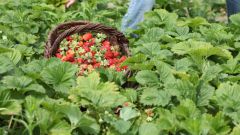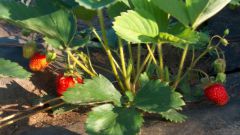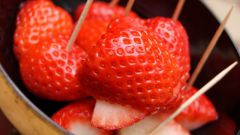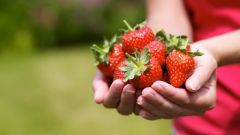Preparing for winter starts in the summer
The main condition under which the normal strawberries will survive the winter, - healthy and strong leaves, regrown after cutting. And so they was exactly have all summer to observe the leaves that accompany the strawberry Bush the whole summer. Because in the case of their disease, decay or damage by pests, all the problems will move to the new leaves, and they, weak and sickly, it will be difficult to cope with the cold weather and frost.
When you see the leaves brown spots, lesions or pockets of decay to remove those leaves without regret. Thereby you will improve the shoots and ensure the normal course of the upcoming winter.
In summer during the growth stage and fruiting period fertilize the strawberries. At the stage of growth, fertilize with organic matter (1 part mullein tincture to 10 parts water) or compound fertilizer (1 tablespoon of NPK per 10 liters of water). Consumption: under one root 0.5 l During budding and the appearance of the first berries strawberries need more potassium, so use wood ash or potassium nitrate (other names potassium nitrate, potassium nitrate). In August to feed the strawberry bushes urea (30-40 g per 10 liters of water), it will provide a good Foundation and increase flower buds.
After harvest, carefully vzryhlite the soil around the bushes and over mulch of pine needles or straw. Aisle can shallow dig. Don't do this on the eve of cold weather, because accidentally damaged the roots will not have time to recover, and it will not affect the stability of the hive during the winter.
Pruning strawberries
The crop of strawberries is to remove the leaves from each Bush. Doing this usually immediately after harvest, the deadline is the end of August. The procedure allows to avoid rotting of the leaves and spread the rot around the berry bushes. Cut carefully, trying not to damage the new thin stalks growing from the center of the Bush. After cropping can feed strawberries organic or compound fertilizer (1 Cup of ash per 10 liters of water or 2 tbsp of NPK 10 liters). This will give a good strong growth of new leaves and will contribute to the laying of flower buds, providing a future rich harvest.
After pruning leaves, check for visible soil from the root collar. If you notice such backfill them land.
Winterizing strawberries
The main insulation for strawberries is snow. This is the best "blanket" brings warmth to the plants, preventing it from freezing and death of the root system. So with the first snow throw it on the strawberry plants and increase the cover with each new snowfall. If came the frosts, and no snow, take care of strawberries this way: type in the forest pine branches and cover them with the berries. Will also fit a large straw and sawdust or shavings. If you do not take timely action on warming, strawberries may die, because its roots are located very close to the surface, the frost will not regret it.
Remember that such shelter as twigs, straw, and particularly shavings are not safe for the plants, as well absorb and accumulate moisture. Strawberries can sopret or rot. Don't make the layer of cover is too thick and dense. If you have the opportunity to visit the dacha and winter, then do attempt to ventilate the plants under the shelter of spruce branches, straw or shavings. Placed the end under covering material of the stick (the handle of a shovel), gently lift it. Repeat this procedure around the berry bushes.
Recently, growers began to use insulating material – and agro-fibre. It protects the plants from accumulation of excessive moisture, reliably protects from frost and rodents, and even let the sunlight in. This allows you to grow strong and healthy strawberries even after the most severe winter.
Do not rush to cover the plants well established before the onset of frost, and especially before the first frost. Give the strawberry plants a chance to toughen up, so they are much better cope with the cold winter weather.




